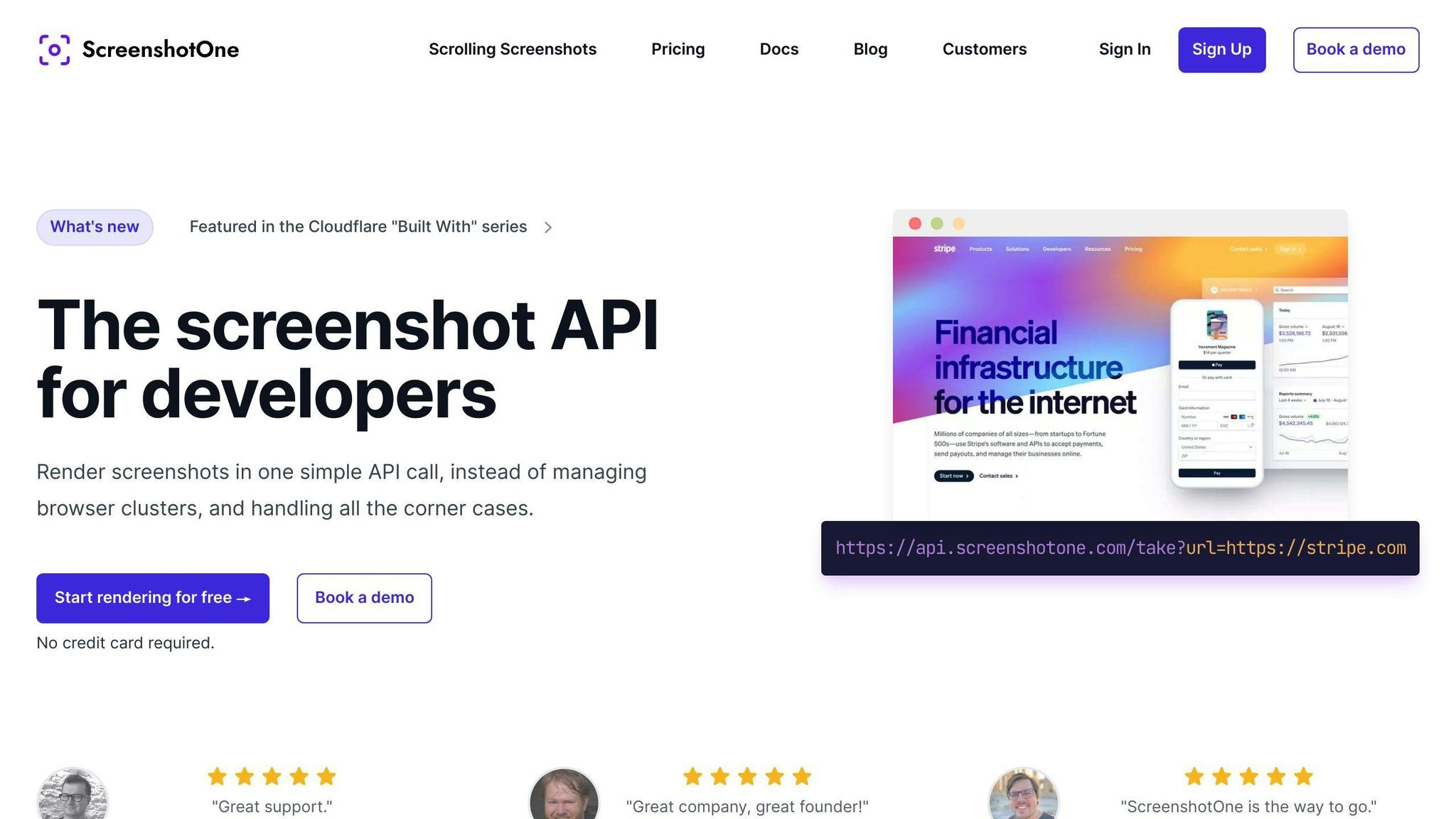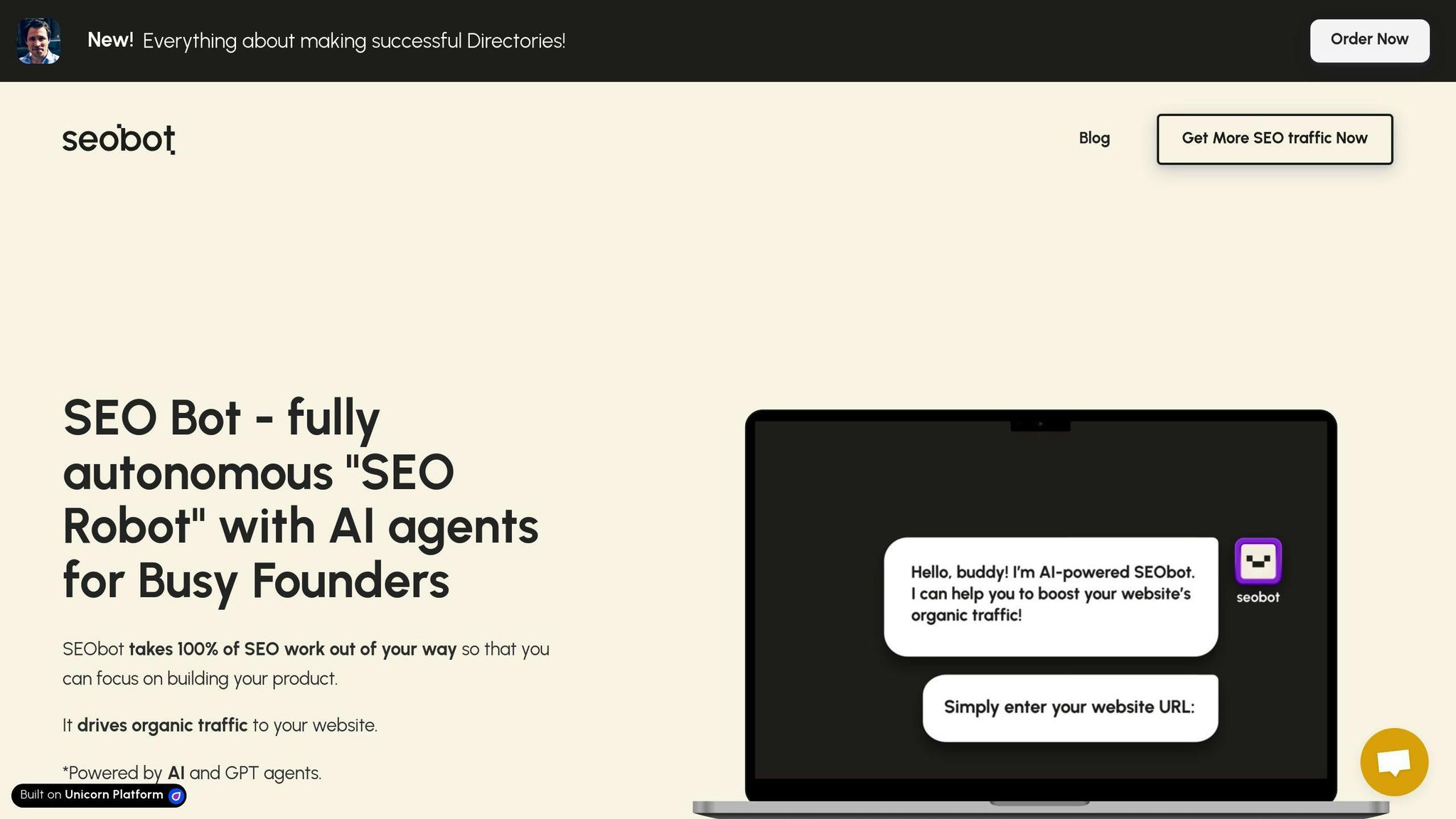Combine SEObot and ScreenshotOne API to automatically generate high-quality, customizable screenshots for your articles, enhancing user experience and SEO.
Key Benefits:
- Improve readability and user engagement with visually appealing screenshots
- Increase visibility in image searches, driving more organic traffic to your site
- Streamline content creation by automating screenshot generation
- Customize screenshot dimensions, format, quality, and timing to fit your needs
How it Works:
- Create a ScreenshotOne account and obtain API credentials
- Configure the ScreenshotOne API settings in SEObot
- Customize screenshot attributes like dimensions, format, quality, and timing
- Automate screenshot creation for new and existing articles
Optimize and Troubleshoot:
- Adjust screenshot attributes to enhance quality and performance
- Leverage caching and image compression for faster load times
- Solve common issues like authentication errors and delayed generation
Related video from YouTube
Getting started
Before we dive into the integration process, let's cover the initial requirements to ensure a seamless experience.
Create a ScreenshotOne account

To get started, you'll need to create a ScreenshotOne account. This will provide you with access to their API, which is necessary for integrating with SEObot. Follow these steps to create your account:
1. Go to the ScreenshotOne website and click on "Sign up"
2. Fill out the registration form with your details
3. Verify your email address by clicking on the link sent to you by ScreenshotOne
4. Log in to your new account and familiarize yourself with the dashboard
Understand SEObot's capabilities

SEObot is a powerful tool that can help you optimize your content for search engines. When integrated with ScreenshotOne, it can automatically generate high-quality screenshots for your articles. Here's how SEObot enhances your content creation process:
| Benefits | Description |
|---|---|
| Improved user experience | SEObot helps you create engaging visuals, making your articles more appealing to readers. |
| SEO benefits | By including images with good descriptions, your blog can show up in image searches, attracting more visitors to your site. |
| Streamlined content creation | SEObot automates the screenshot generation process, saving you time and effort. |
Now that you have a ScreenshotOne account and understand SEObot's capabilities, you're ready to move on to the next step: setting up the ScreenshotOne API.
Step 1: Set up ScreenshotOne API
Now that you have a ScreenshotOne account and understand SEObot's capabilities, it's time to set up the ScreenshotOne API. This step is crucial for integrating ScreenshotOne with SEObot and generating high-quality screenshots for your articles.
Obtain API Credentials
To set up the ScreenshotOne API, you'll need to obtain your API credentials. Follow these steps:
1. Log in to your ScreenshotOne account and navigate to the API dashboard. 2. Click on the "API Credentials" tab and copy your API key and secret key. 3. Store your API credentials securely, as they will be used to authenticate your API requests.
Configure API Settings
Next, you'll need to configure your API settings to match SEObot integration requirements. This includes setting up the API endpoint, specifying the output format, and configuring any additional settings required for your use case.
Here are some key settings to consider:
| Setting | Description |
|---|---|
| API Endpoint | The URL of the ScreenshotOne API endpoint. |
| Output Format | The format of the screenshot output (e.g., PNG, JPG, etc.). |
| Delay | The time delay between API requests (optional). |
| Block Ads | Whether to block ads on the webpage before taking a screenshot (optional). |
Step 2: Connect SEObot and ScreenshotOne
Now that you've set up the ScreenshotOne API, it's time to connect it with SEObot. This integration enables automatic and customizable screenshot generation for your articles.
Configure API settings
To connect SEObot and ScreenshotOne, you'll need to configure the API settings. This step is crucial for ensuring proper integration and screenshot generation. Follow these steps:
- Log in to your SEObot account and navigate to the API settings.
- Enter your ScreenshotOne API credentials, including the API key and secret key.
- Configure the API endpoint, output format, and any additional settings required for your use case.
API Settings
| Setting | Description |
|---|---|
| API Endpoint | The URL of the ScreenshotOne API endpoint. |
| Output Format | The format of the screenshot output (e.g., PNG, JPG, etc.). |
| Delay | The time delay between API requests (optional). |
| Block Ads | Whether to block ads on the webpage before taking a screenshot (optional). |
Customize screenshot generation
Once you've configured the API settings, you can customize the screenshot generation process within SEObot. This allows you to personalize the settings for optimal screenshot quality and relevance in the context of your targeted articles.
Customization Options
- Screenshot dimensions: Specify the width and height of the screenshot output.
- Browser type: Choose the browser type for screenshot generation (e.g., Chrome, Firefox, etc.).
- Device type: Select the device type for screenshot generation (e.g., desktop, mobile, etc.).
- Cookies and JavaScript: Configure whether to enable or disable cookies and JavaScript during screenshot generation.
sbb-itb-b8bc310
Step 3: Automate screenshot creation
Now that you've connected SEObot and ScreenshotOne, it's time to automate screenshot creation for your articles. This step is crucial for reducing manual effort and consistently enhancing your content with visual elements.
Optimize automated screenshots
To ensure that your automated screenshots are perfectly tailored to complement your article content and enhance user engagement, follow these tips:
| Tip | Description |
|---|---|
| Customize screenshot dimensions | Adjust the width and height of your screenshots to fit your article's layout and design. |
| Choose the right browser type | Select the browser type that best represents your target audience's browsing experience. |
| Optimize for mobile devices | Ensure that your screenshots are optimized for mobile devices to cater to the growing mobile user base. |
| Use relevant delay and block ads settings | Configure the delay and block ads settings to capture screenshots that accurately represent your article's content. |
Customization options
Customizing your screenshots is crucial to ensure they fit your article's style and needs. ScreenshotOne API provides various options to help you achieve the perfect fit.
Adjust screenshot attributes
You can modify the following screenshot attributes to suit your article's requirements:
| Attribute | Description |
|---|---|
| Dimensions | Adjust the width and height of your screenshots. |
| Format | Choose from various formats, such as PNG, JPG, or WebP. |
| Quality | Set the quality of your screenshots to balance file size and image clarity. |
| Timing | Configure the delay and block ads settings to capture screenshots that accurately represent your article's content. |
By adjusting these attributes, you can create high-quality, engaging screenshots that enhance your article's readability and user experience.
Additionally, ScreenshotOne API offers advanced features for developers, such as custom CSS, JavaScript, and header settings, to further customize your screenshots.
Remember to explore ScreenshotOne API's documentation and code examples to unlock the full potential of its customization options and create visually appealing screenshots that elevate your article's engagement and readability.
Troubleshooting and tips
Solve common issues
When integrating ScreenshotOne API with SEObot, you might encounter some common issues that can hinder the screenshot generation process. Here are some potential challenges and their solutions:
| Issue | Solution |
|---|---|
| API authentication errors | Double-check your API credentials and ensure they are correctly configured in SEObot. |
| Screenshot quality issues | Adjust the screenshot attributes, such as dimensions, format, and quality, to optimize the output. |
| Delayed screenshot generation | Verify that your server-side settings are optimized for efficient screenshot generation. |
Optimize performance
To further enhance the performance of your automated screenshot generation, consider the following tips:
- Optimize server-side settings: Ensure your server is configured to handle the screenshot generation process efficiently, reducing latency and improving overall performance.
- Use image compression: Compress your screenshots to reduce file size and improve page load times, resulting in a better user experience.
- Leverage caching: Implement caching mechanisms to store generated screenshots, reducing the load on your server and improving overall performance.
Summary
Key Takeaways
In this guide, we've shown you how to combine SEObot with ScreenshotOne API to generate high-quality screenshots for articles. By automating screenshot creation, you can:
| Benefits | Description |
|---|---|
| Improve SEO | Increase visibility in image searches, driving more traffic to your site |
| Enhance readability | Make articles clearer and more engaging, leading to higher shares |
| Save time | Focus on optimizing your SEO strategy instead of creating screenshots manually |